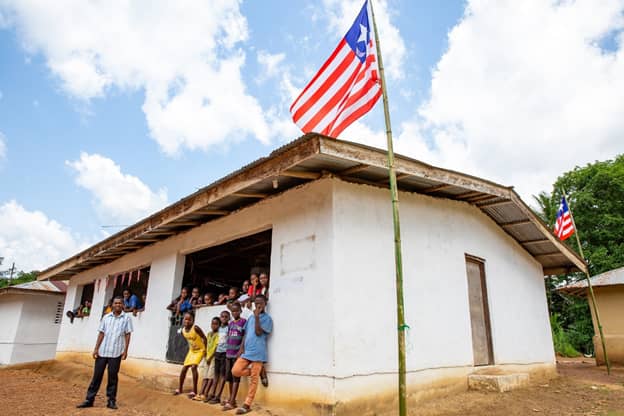“It has gotten really tough for us,” says James, a father in rural Liberia, of COVID-19 lockdown and school closures. “My son is trying but he is missing his friends and teachers. Children want to be in school.”
“When Coronavirus passes, will your school still be there to help us with our children?” asks Fatu, a Liberian mother of six.
Around the world, over one billion children are out of school. All will face learning losses (data from World War II and other crises offer grim indications on this) and far too many will be lost to learning forever. Estimates suggest the COVID-19 pandemic will cause this generation to lose $10 trillion in future earnings.
Headlines exclaim that the global education system has never seen a moment like this and, in some sense, that is true. However, in Liberia, where we work, this is the second pandemic in six years. Our experiences in Liberia provide important lessons for COVID-19 education system recovery in low-income countries – and the uniquely important role of “last mile teachers.”

In 2014, the Ebola crisis closed schools across Liberia for six months to a year. One and a half million children were excluded from school, in addition to 500,000 children who were already excluded before Ebola roared through the country.
As Liberia’s Minister of Education, I led the country’s education response. I traveled with my team to schools across Liberia, speaking with teachers, parents, and children to assess the magnitude of the task to bring children back to learning.
I concluded that the education system was failing and bold reform was needed urgently: the Ministry of Education needed to rethink everything about its education delivery system for post-Ebola Liberia. The Luminos Fund, where Caitlin is CEO, was one of several education organizations that launched operations in Liberia as part of the recovery journey following Ebola.
Reflecting on past school closures in Liberia and beyond, and our experience educating vulnerable children, we identify three key steps for education systems to come back strong after a crisis like COVID-19.
First, targeted outreach must be conducted to bring the most vulnerable and older students back to school. Next, each child should be assessed to understand the extent of their learning loss, and to meet students where they are in the curriculum. Finally, remediation should be provided to bring students who have fallen behind back up to grade level.
Here is the key, and challenge: all of these steps rely on the efforts and tenacity of frontline educators, but low-income countries do not have nearly enough teachers. UNESCO estimates a global shortage of nearly 69 million teachers, 70% of whom are needed in sub-Saharan Africa.

Furthermore, many countries cannot graduate teachers fast enough to fill the shortfall. South Sudan, for example, would need all of its projected graduates from higher education – twice over – to become teachers to fill its gap. Traditional teacher training alone is insufficient to meet demand, even before the COVID-19 pandemic.
Some non-governmental organizations (NGOs) are helping address the need. The Luminos Fund manages an education program in Liberia that has achieved powerful success with a different model of teacher preparation (James’s son and Fatu’s daughter are students this year).
Luminos recruits local, motivated, high-potential young people with minimal qualifications as teachers. The program has shown that, with intensive three-week training followed by ongoing classroom-based coaching, these recruits deliver transformative learning for children who are often the first in their families to learn to read.
Luminos teachers are so successful that, in less than one year, their students advance from still learning the alphabet to reading 39 words a minute. After one year of schooling, Luminos students read at a rate that only 15% of Liberian third graders can match.
Today, school systems across Africa and beyond must think expansively about the assets they can deploy to respond to the current crisis – and take action. Status quo thinking is inadequate to respond to the moment.
Here, Liberia has another powerful lesson to share with this world. In the provision of basic healthcare, Liberia hosts perhaps the world’s most famous example of the creative extension of government delivery capacity through collaboration with civil society: Last Mile Health.

Last Mile Health has reached over 1.2 million of the poorest Liberians through a network of 3,600 community and frontline health workers. Community health workers are paid professionals, recruited from these same poor communities and empowered to provide basic healthcare in consultation with the formal system.
This model is now being scaled to reach nine million people with primary care services globally by 2030. Last Mile Health has created a model community health system in Liberia and marshalled a movement to develop the global workforce of community and frontline health workers.
The same approach could be used in education and is not dissimilar to how Luminos operates. Far too often, though, the global education sector has viewed community-based educators as a threat, unlike global health’s careful but open-minded exploration of alternative models.
The world may never see another global school closure like the one we are experiencing, but in Liberia, COVID-19 is the second pandemic in six years. Low-income countries – and countries everywhere – need to build resilient school systems that can weather periodic closures and still deliver transformative learning for students.
Building a global workforce of frontline education staff from remote communities to serve remote communities – last mile teachers – is a critical part of the formula.
Source IPS

